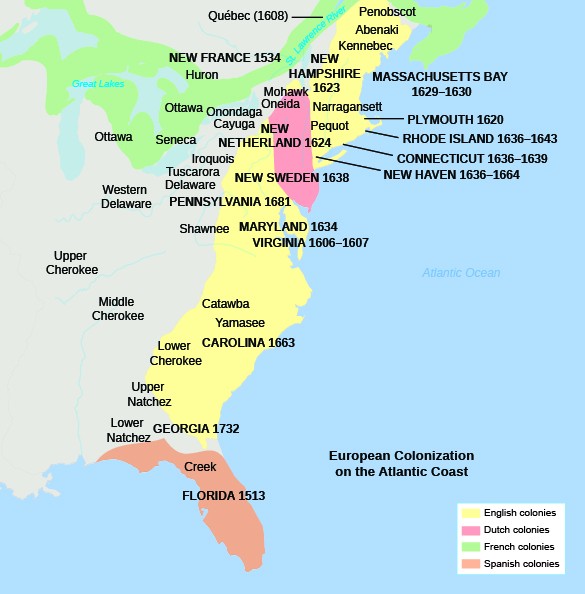6 Introduction-European Exploration Accounts
Wendy Kurant
Spain, the first European country to establish a significant foothold in the Americas in the fifteenth century, was not looking for previously unknown lands at all. It was looking for a westward passage to Asia. Earlier in the century, the Ottoman Empire had captured Constantinople and after that point, controlled the territory through which the traditional land‑based trade routes to China and India ran, effectively giving the Ottoman Empire a monopoly on trade between Europe and Asia. Spain, like other European nations, looked for a solution by seeking a westward route. Spain at that time did not exist as a unified nation but rather was a collection of kingdoms, sometimes collaborating but more often competing with each other. The move toward nationhood began when King Ferdinand II of Aragon and Queen Isabella I of Castile married in 1469 and unified two of the more powerful Iberian kingdoms. To consolidate their economic and regional power, these monarchs were very interested in securing trade routes for the very lucrative commodities coming from the east. Additional motivation came from a powerful rival within the same peninsula. Portugal had already circumnavigated Africa and looked poised to discover that westward passage. Those influences encouraged King Ferdinand and Queen Isabella to support Christopher Columbus’ proposal of finding a western route. Unaware that a landmass intervened between the Atlantic and Pacific Oceans and miscalculating the distance between western Europe and eastern Asia, Columbus thought he had succeeded in his quest when he landed on islands in the Caribbean. He hadn’t, but Spain discovered that the New World had desirable commodities too, namely gold and silver mines that funded Spain’s empire‑building aspirations.
Just as the powerful European nations fought for supremacy within the confines of the European continent, they also grappled over territory in the Americas. Like Spain, other European countries sought new trade routes and, failing that, coveted the new land as a source of commodities such as precious metals, fur, timber, and agricultural products and as an extension of their empires. Spain primarily explored and appropriated areas in South and Central America and in the southeastern and southwestern parts of North America. Holland has the smallest territory for the briefest amount of time in the Americas, controlling the Hudson River Valley from New York City to Albany as well as the western tip of Long Island for little more than fifty years before losing it to the English in 1664 as part of the settlement of the Second Anglo‑Dutch War. The French territories concentrated primarily in the Canadian areas of Newfoundland to Quebec as well as around the Great Lakes and a large swath of land in the midsection of the country from the Rocky Mountains to the Mississippi River delta. England, one of the last major European powers to create settlements in North America, ultimately ended up having the largest and most lasting colonial reach, starting with their first permanent settlement in Jamestown in 1608, and expanding along the eastern seaboard where they frequently clashed with Spanish territories to the south and Dutch and French territories to the north and west. A small and densely populated island with a system of primogeniture which increasingly invested land in fewer and fewer hands, England was the European country most in need of agricultural settlements in North America. In addition to supplying food and goods to a mother country, it provided land for younger sons and those without prospects at home as well as a convenient place to send unruly groups within the population.
Figure 1. “European Colonization on the Atlantic Coast”

The relationship between imperialism and the spread of religion in the new world was first cemented during Spanish exploration. In a 1493 papal bull, Pope Alexander VI granted Ferdinand and Isabella and their heirs the right to any lands they “discovered towards the west and south” of a demarcation line that was not already in the possession of a Christian monarch so that “the Catholic faith and the Christian religion [would] be exalted and be everywhere increased and spread.” Like the Spanish, French explorers were also accompanied by missionaries to convert North American natives to Catholicism, though they did so with less fervor and less coercion than their co‑religionists from Spain. Dutch explorers showed little interest in converting the natives, as Holland had a policy of religious toleration during the time in which it colonized North America. The Church of England had already seceded from the authority of the Catholic Church by the time Jamestown was established, and though the charter from King James emphasized the motive of spreading the Christian faith and church attendance was mandatory in Jamestown’s early years, more energy was put into survival and trade than into proselytizing the natives. It was the later colonies founded by Separatists and Puritans that came to the new world with the primary intention of spreading the beliefs of their denominations.
The initial function of the exploration accounts to follow in this section was to report back to the governments and organizations that funded the expeditions. However, the invention of the Gutenberg press with its movable type and increased productivity meant that these accounts could be more easily printed and more widely disseminated. Speaking to a wider audience, these accounts fulfilled other purposes as well. They served as written records of a nation’s claim to a territory, as tales of exotic lands and thrilling adventure, and as testimonials to lure more people into investing in and emigrating to these fledgling colonies.
Source:
Becoming America, Wendy Kurant, ed., CC-BY-SA
Image Credit:
Figure 1. “European Colonization on the Atlantic Coast,” by Open Stax, from U.S. History, CC-BY 4.0.

